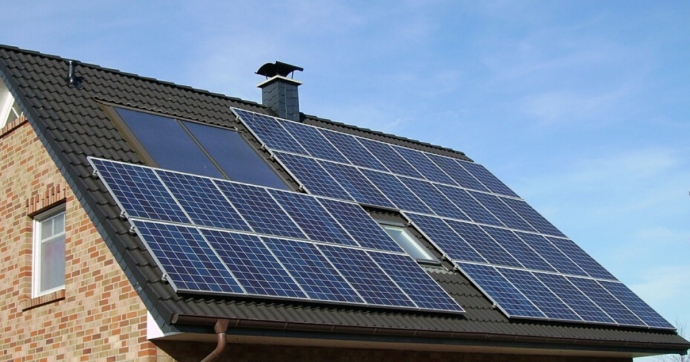We Could Have 100% Renewable Electricity If We Had Invested in Wind and Solar Instead of War in the Middle East
Yes, the United States could be generating 100% of its electricity from renewable energy if we had used the money spent on our ill-advised wars in the Middle East to build wind and solar systems, as well as battery storage, here at home.That’s the startling conclusion of a simple calculation my colleague Robert Freehling and I made after the latest reports on the economic cost of our wars in the Middle East.
This is, after all, not rocket science. Money spent on war–anywhere–is money lost. It’s not an investment in the future. It’s money quite literally that goes up in smoke.
In contrast, money spent on building wind and solar farms or putting solar systems on rooftops is money invested in the future that will be earning returns–in the form of electricity–for 20 to 30 years.
I’ve followed this topic since the invasion of Iraq in 2003. I posted my first article on this subject on July 4, 2005, and I’ve been updating that article periodically since then as the cost of our wars continued to grow.
On the anniversary of September 11th this year, news articles on the cost of the war in Afghanistan prompted me to take another look at our lost opportunities to invest in infrastructure here at home for the direct benefit of Americans.
What I learned shocked me. Using what I call a back-of-the-envelope method, I calculated that we could have installed enough wind turbines to more than provide 100% of our electricity with what we’d spent on war.
That just didn’t seem right. These are big numbers and it’s easy to get them wrong. After all, we’ve been told for decades that it’s simply too expensive to install that many wind turbines and solar panels. We could never afford it, critics warned.
So I called my colleague and renewable energy analyst Robert Freehling for help. I’ve relied on Freehling to sort out such thorny problems in the past.
His conclusion? Yes, we could be generating 100% of our electricity in this country from just wind and solar; that is, not counting existing hydro, geothermal, or biomass generation. Freehling, though, goes even further. We would be generating so much renewable electricity that we could store huge amounts in batteries–electricity storage that also would be paid for with our “war savings.”
How did we reach such a conclusion? Did we use a supercomputer to calculate all the possible permutations of what a renewable electricity supply would look like?
No. We kept it simple. We looked at two respected estimates of what our wars have cost in economic terms to the US taxpayer, not what they’ve cost in human suffering, nor what they’ve cost the countries on the receiving end of our expenditures.
The National Priorities Project calculates that the wars in the Middle East since 2001 have cost $4.9 trillion, a sum that continues to rise. The Watson Institute for International and Public Affairs at Brown University estimates $5.9 trillion through Fiscal Year 2019. Their latest estimate raises that to $6.4 trillion through FY 2020.
To paraphrase Senator Everett Dirksen, “A trillion here, a trillion there and pretty soon it adds up to real money.” For a sense of perspective, one billion is 1,000 million. Thus, a trillion is one million million. That’s a one with twelve zeros behind it–a very big number.
We made no attempt to match the annual costs of the wars to the deployment of wind and solar. Again, we kept it simple. We simply prorated the costs over two decades with the exception explained below.
Freehling’s simple spreadsheet model assumes ramping up installations from a low base over a decade to reflect the necessity of scaling up manufacturing to meet the demand. Then he held installations constant for another decade until he reached 100% renewable generation from wind and solar. If we had started in 2001, the whole conversion would be accomplished by 2020.
Shockingly, there was a lot of money left over. So Freehling plowed the remainder into battery storage using the same approach as with wind and solar. He scaled installations up from a low base until the industry was likely to reach maturity.
Existing renewable generation from hydro, geothermal, and biomass was then shunted into the mass of new storage. Batteries would be used to equalize the grid when winds were light or the sun had set. The remainder could then be used to charge electric vehicles.
Wind and solar are cheap today. That was not so, two decades ago. Freehling accounts for this by using historical figures for the cost of wind and solar.
He dropped the initial cost of wind from $2,500 per kilowatt of installed capacity in the year 2000 to about $1,400 today.
Solar has seen a dramatic drop in cost during the past two decades. Freehling used $12,000 per kilowatt as the cost of solar capacity in 2000 and dropped it to nearly $1,500 per kilowatt in 2020.
We apportioned how much wind and how much solar were built, based on the work of my French colleague Bernard Chabot. He found that for a temperate climate, such as the United States, the optimum mix of generation is 60% wind and 40% solar energy. This mix minimizes the amount of storage needed.
Batteries are still expensive. The cost of battery storage, however, has fallen 80% in the past decade alone notes Freehling. He suggests that the cost of battery storage would have fallen even more rapidly through economies-of-scale if we had begun deploying them at scale sooner. Batteries for Electric Vehicles (EVs) would also be cheaper today if we had plowed some of our war savings into battery development.
Here in California, the Independent System Operator (Cal-ISO) requires 4-hours of storage for it to reliably meet peak demand.” Our scenario calls for one million megawatts of wind and another one million megawatts of solar. This scenario uses some 700,000 MW of batteries to store 3 terawatt-hours (TWh) or 3 billion kilowatt-hours of electricity. The amount of storage is approximately enough to meet the peak electricity demand for the entire United States for a period of 4 hours.
All together, wind, solar, and storage would be capable of providing 4,400 TWh per year–the amount of electricity generated annually in the United States–for an investment of $6 trillion over two decades.

If we had instead invested the $6 trillion we squandered on war in the Middle East, we would, two decades later, have made our grid more resilient with battery storage, and be generating 100% of our electricity with wind and solar. Moreover, existing sources of renewable energy would be sufficient to power a substantial portion of our passenger cars with clean, renewable electricity.
Incredible.
What a lost opportunity.
———-
Paul Gipe is a renewable energy analyst and the author of Wind Energy for the Rest of Us. He has worked with wind energy for the past four decades.
- Beating Swords into Wind Turbines–or Solar Panels if You Like, December 29, 2007. This op-ed was originally posted on July 4, 2005 and then appeared at Renewable Energy Access.com (Now RenewableEnergyWorld.com) on July 11, 2005. This version has been updated with current figures for the cost of the war and estimates of its total direct and indirect costs (to the USA only).













